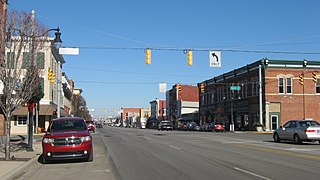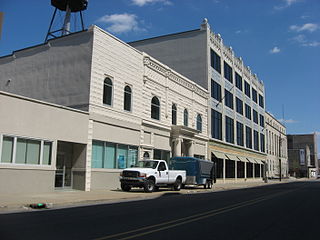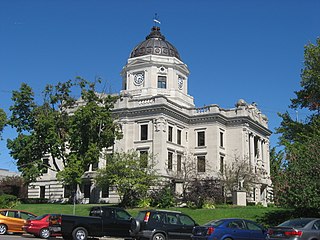
Independence Historic District, also known as the West Franklin Street-Wabash Avenue Historic District, is a national historic district located in the Lamasco neighborhood of Evansville, Indiana. The district developed after 1880, and encompasses 95 contributing buildings and 1 contributing site. It includes commercial and residential properties and representative examples of Italianate, Queen Anne, Romanesque, and Beaux-Arts style architecture. Notable buildings include the West Branch Carnegie Library (1912), Laval Block, Heldt-Voelker Hardware Store (1890), First Federal Savings, Gerke Building, August Rosenberger House (1894), and St. Boniface Church.

Columbus Historic District is a national historic district located at Columbus, Bartholomew County, Indiana, United States. It encompasses 574 contributing buildings and 1 contributing sites in the central business district and surrounding residential areas of Columbus. It was developed between about 1850 and 1930, and includes notable examples of Federal and Italianate style architecture. A number of commercial buildings feature locally manufactured cast iron and pressed metal components. Located in the district are the separately listed Bartholomew County Courthouse, Columbus City Hall, and First Christian Church. Other notable buildings include the First National Bank, The Crump Theatre (1889), Reo Theater, Ulrich Bakery, Samuel Harris House (1853), Keller House (1860), Old Post Office (1910), Franklin Building, Gent Mill, First United Presbyterian Church (1871-1885), Irwin Block, Irwin Home and Gardens, and St. Batholomew's Roman Catholic Church (1891).

Elkhart Downtown Commercial Historic District is a national historic district located at Elkhart, Elkhart County, Indiana. The district encompasses 59 contributing buildings in the central business district of Elkhart. It was developed between about 1868 and 1930, and includes notable examples of Italianate, Queen Anne, and Classical Revival style architecture. Located in the district are the separately listed Green Block, Lerner Theatre, and Young Women's Christian Association. Other notable buildings include the Cornish Block, Franklin Street Station (1895), Menges Building (1908), former Post Office (1905), Midwest Museum of Modern Art (1922), Elkhart Water Company, Masonic Temple, Rowe Block (1900), and Dreves Building.

Brookville Historic District is a national historic district located at Brookville, Franklin County, Indiana. The district encompasses 682 contributing buildings in the central business district and surrounding residential sections of Brookville. It developed between about 1811 and 1913, and includes notable examples of Federal and Greek Revival style architecture. Located in the district are the separately listed Franklin County Seminary and The Hermitage. Other notable contributing buildings include the James Brown Ray House (1811-1820), Old State Bank, James N. Tyner House, Old Brick Meeting House (1810-1821), Franklin County Courthouse (1853-1859), St. Michael's Catholic Church, Howland-Farquahar-Goodwin House (1855), Valley House Hotel (1842), and the Presbyterian Church (1854-1855).

Marion Downtown Commercial Historic District is a national historic district located at Marion, Grant County, Indiana. It encompasses 52 contributing buildings, 2 contributing structures, and 1 contributing object in the central business district of Marion. It developed between about 1870 and 1942, and includes notable examples of Italianate, Romanesque, and Classical Revival style architecture. Located in the district is the separately listed Grant County Jail and Sheriff's Residence. Other notable buildings are the Grant County Courthouse (1881–1883), Marion Bank Building, Iroquois Building, Dan-Mar Apartments, United Telephone Block, Cecelian Apartments, Marion Post Office, and William Smith Building / Mecca Club.

Portland Commercial Historic District is a national historic district located at Portland, Jay County, Indiana. It encompasses 58 contributing buildings, 1 contributing structure, and 1 contributing object in the central business district of Portland. The district developed between about 1870 and 1945, and includes notable examples of Italianate, Romanesque Revival, Classical Revival, and Early Commercial style architecture. Located in the district is the separately listed Jay County Courthouse. Other notable contributing resources include the U.S. Post Office (1914) designed by the Office of the Supervising Architect under Oscar Wenderoth, Portland Fire Station #1 (1929), Citizens Bank, FOE Eagles Lodge (1883), Johnson Building, Stevens Building (1910), Walnut Street Church of Christ (1913), and South Meridian Street Bridge (1914).

Greenwood Commercial Historic District is a national historic district located at Greenwood, Johnson County, Indiana. The district encompasses 25 contributing buildings in the central business district of Greenwood. It developed between about 1860 and 1935, and includes notable examples of Italianate, Romanesque, and Classical Revival style architecture. Notable buildings include the Grafton Peek Building (1887), former Odd Fellows Hall, former Masonic Lodge (1909), G.W. Clemmons Block (1906), and the Interurban Public Service Company and Interurban Station.

Edinburgh Commercial Historic District is a national historic district located at Edinburgh, Johnson County, Indiana. The district encompasses 48 contributing buildings in the central business district of Edinburgh. It developed between about 1854 and 1941, and includes notable examples of Italianate, Late Victorian and Classical Revival style architecture. Notable buildings include the Edinburgh Interurban Depot (1919), Mooney House, A. C. Thompson / Danner Building (1854), A. C. Thompson Bank (1872), Masonic Temple (1915), IOOF Building (1888), Central Hotel / Toner House (1855), and Edinburgh Town Hall (1920).

Martin Place Historic District is a national historic district located at Franklin, Johnson County, Indiana. The district encompasses 27 contributing buildings 1 contributing structure, and 1 contributing object in an exclusively residential section of Franklin. It developed between about 1850 and 1935, and includes notable examples of Italianate, Queen Anne, American Foursquare, and Bungalow / American Craftsman style architecture.

State Street Commercial Historic District is a national historic district located at Hammond, Lake County, Indiana. The district encompasses 28 contributing buildings in the central business district of Hammond. It developed between about 1885 and 1946, and includes notable example of Commercial, Classical Revival, Late Gothic Revival, and Art Deco style architecture. Notable buildings include the L. Fish Building (1927), Federal Building (1939), Lincoln Hotel (1923), Seifer Building (1925), and the Henderson Building (1902).

Hobart Commercial District is a national historic district located at Hobart, Lake County, Indiana. The district encompasses 38 contributing buildings in the central business district of Hobart. It developed between about 1869 and 1963, and includes notable example of Italianate, Classical Revival, and Art Deco style architecture. Notable buildings include the Verplank Building (1928), Orcutt Hotel and Office / Mander Building (1915), Fiester Building (1907), Fiester Building (1890-1893), Hobart Bank, Art Theater, Ben Ack Building (1926), Hobart Post Office, Roper Building / American Bank and Trust, First State Bank, Lake George Hotel / Stocker Building, Schultz Brothers Variety Store (1947), and the Kostbase Building (1950).
Hohman Avenue Commercial Historic District is a national historic district located at Hammond, Lake County, Indiana. The district encompasses 15 contributing buildings in the central business district of Hammond. It developed between about 1904 and 1956, and includes notable example of Romanesque Revival, Classical Revival, and Colonial Revival style architecture. Notable buildings include Knott's Apartments (1904), Emmerling Ambulance Garage (1918), Emmerling Building (1918), St. Joseph's Roman Catholic Church Complex, LaSalle Hotel, OK Building (1913), and the Hammond National Bank.

Franklin Street Commercial Historic District is a national historic district located at Michigan City, LaPorte County, Indiana. The district encompasses 73 contributing buildings and 1 contributing object in the central business district and surrounding residential section of Michigan City. It developed between about 1875 and 1955, and includes examples of Italianate, Gothic Revival, Queen Anne, Classical Revival, and Tudor Revival style architecture. Located in the district is the separately listed Michigan City Post Office (1909-1910). Other notable buildings include the Staiger House, Earl House, M & M Diner (1955), Zorn Building (1907), St. Paul's Lutheran Church (1876) and rectory (1888), First Federal Savings Bank, Aicher Block (1914), Brinkman Building, Trinity Episcopal Church (1889), Merchants National Bank Building (1926), Ledbetter Building (1908), Rodenbeck Saloon, First Methodist Episcopal Church (1922), Barker Hall (1929), Masonic Temple (1922-1923), and the Salvation Army Building (1925).

Bloomington West Side Historic District is a national historic district located at Bloomington, Monroe County, Indiana. The district encompasses 394 contributing buildings, 2 contributing sites, and 2 contributing structures in a mixed residential, commercial, and industrial section of Bloomington. It developed between about 1850 and 1946, and includes notable examples of Queen Anne and Bungalow/American Craftsman style architecture. Located in the district are the separately listed Elias Abel House, Cantol Wax Company Building, Coca-Cola Bottling Plant, Cochran-Helton-Lindley House, Illinois Central Railroad Freight Depot, Johnson's Creamery, and Second Baptist Church. Other notable contributing resources include the Works Progress Administration constructed wading pool, White Oak Cemetery, Ninth Street Park, Bloomington Wholesale Foods Warehouse, Bloomington Garage, Curry Buick, Banneker School, Bethel African Methodist Episcopal Church, and Bloomington Frosted Foods.

Courthouse Square Historic District is a national historic district located at Bloomington, Monroe County, Indiana. The district encompasses 57 contributing buildings in the central business district of Bloomington. It developed between about 1847 and 1936, and includes notable examples of Classical Revival, Beaux Arts and Italianate style architecture. Located in the district are the separately listed Bloomington City Hall, Monroe County Courthouse, Princess Theatre, and Wicks Building. Other notable buildings include the Federal Building, Masonic Temple, former Faulkner Hotel, Odd Fellows Building (1892), Allen Building (1907), First National Bank Building (1907), Knights of Pythias Building (1907), and Graham Hotel Building.

Ellettsville Downtown Historic District is a national historic district located at Ellettsville, Monroe County, Indiana. The district encompasses 50 contributing buildings in the central business district and surrounding residential sections of Ellettsville. It developed between about 1840 and 1953, and includes notable examples of Queen Anne, Early Commercial, Gothic Revival, and Bungalow/American Craftsman style architecture. Notable buildings include the Robert Stimson House, May Presley House, Bradford House, George W. Fletcher House, Wickens House (1909), Capt. Gilbert Perry House, I.O.O.F. Building, Town Hall (1927), Masonic Building (1895), Knights of Pythias Building, First United Methodist Church (1900), and First Baptist Church (1909).

Crawfordsville Commercial Historic District is a national historic district located at Crawfordsville, Montgomery County, Indiana. The district encompasses 105 contributing buildings, 1 contributing structure, and 1 contributing object in the central business district of Crawfordsville. It developed between about 1836 and 1940, and includes notable examples of Italianate, Classical Revival, and Bungalow/American Craftsman style architecture. Located in the district are the separately listed Montgomery County Jail and Sheriff's Residence and Otto Schlemmer Building. Other notable buildings are the Montgomery County Courthouse (1876), Ben Hur Life Building (1911), Hanna-Graham Building, Elston Bank Building (1869), Masonic Temple (1902), Carnegie Library (1902), Commerce Building (1907), Municipal Building (1933), Indiana National Guard Armory (1939), and U.S. Post Office (1940).

West Side Historic District is a national historic district located at Shelbyville, Shelby County, Indiana. The district encompasses 373 contributing buildings and 4 contributing structures in a predominantly residential section of Shelbyville. It developed between about 1853 and the 1939, and includes notable examples of Queen Anne, Colonial Revival, and Stick Style / Eastlake movement style architecture. Located in the district is the separately listed John Hamilton House. Other notable buildings include the Peter Metzger House, Joseph Acre House, Earl Karmire House, Charles Davis House, Charles Birely House, Harry Whitcomb House, First Christian Church (1901), C.H. Campbell House, George McConnell House, First Presbyterian Church (1885), John Randall House, Alfred Major House, Frank C Sheldon House, and Edward Thurston House.

Angola Commercial Historic District is a national historic district located at Angola, Steuben County, Indiana. The district encompasses 49 contributing buildings, 1 contributing site, and 2 contributing objects in the central business district of Shelbyville. It developed between about 1861 and the 1960, and includes notable examples of Italianate, Romanesque Revival, Beaux-Arts, Classical Revival, Late Gothic Revival, and Art Deco style architecture. Located in the district are the separately listed Steuben County Courthouse and Steuben County Jail. Other notable buildings include the Angola City Hall, Angola Police and Fire Department Building (1939), First Congregational United Church of Christ (1899), United Methodist Church of Angola (1889), Patterson Block (1861), Jackson Block (1870), Croxton Opera House (1892), Angola Masonic Building (1929), Armory Building (1916), and First National Bank (1923).

Twelve Points Historic District is a national historic district located at Terre Haute, Vigo County, Indiana. It encompasses 12 contributing buildings in a suburban commercial district of Terre Haute. It developed between about 1905 and 1954, with most built between 1890 and 1920, and includes representative examples of Commercial, Art Deco, and Classical Revival style architecture. Notable buildings include the Twelve Points State Bank (1919), People State Bank (1923), Twelve Points Hotel (1908), and Garfield Theater / Harmony Hall (1939).























